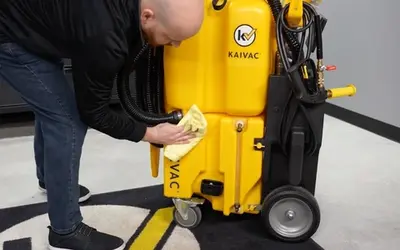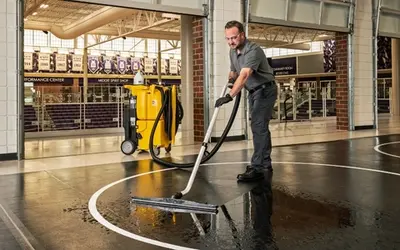Tips for an Odor-Free Restroom

Dirty restroom stink. Ironically, freshly-cleaned restrooms can be pretty stinky too. If your facilities smell bad, don’t blame the maintenance crew. They’re working hard for an odor-free restroom, but all of that scrubbing, wiping and mopping only makes bad odors worse.
Nasty restroom smells come from a variety of sources. Some are the usual suspects, other may surprise you. No matter the source, malodorous restrooms make a bad impression. And if you think layering in a mist of artificial-pine-scented air freshener will solve the problem, think again. Perfumes and sprays don’t fool anyone.
Follow these tips for an odor-free restroom that will keep customers happy.
What’s That Smell?
Some restroom smells are as expected as they are fleeting. Sure, they’re a pretty offensive part of life but thankfully dissipate quickly. It’s the lingering odors, the ones that hit you first thing in the morning and never seem to go away even after a thorough cleaning, that truly frustrate.
These pernicious smells are born from three culprits: bacteria, molds and humidity.
Bacteria feeds on urine which, no surprise here, is in constant supply thanks to accidental splashes, spraying from fixture flushes and good old missing the target. The bacteria digest the urea, proteins and carbohydrates, emit malodors and continue to multiply. The more bacteria you have the worse the smell gets.
Molds and mildews also generate unpleasant odors, along with other more serious complications like itchy eyes, runny noses, rashes and more. If there are black specks on the ceiling and walls or green debris around pipes and a lingering musty smell, you may have a mold problem.
Humidity doesn’t smell, per say, but it does provide perfect growing conditions for mold, mildew and bacteria. Controlling humidity is an important part of controlling smells.
If your restroom smells like rotten eggs you may have a sewer gas problem. Caused by faulty equipment like cracked seals or a dried-out trap, sewer gas wafts back up from the pipes and the smell is unmistakable. This odor can be dangerous as it contains toxic pathogens like hydrogen sulfide.
Where’s That Smell?
You have to know where bacteria, mold and mildew like to hide out to fully remove them and their terrible smells. The likely offenders are:
- Grout: Rough, porous and difficult to fully clean, grout is the number one source of restroom stink. Urine soaks into the material and bacteria latch on to feed, grow and multiply. Mopping doesn’t remove the bacteria but does deposit a nutrient-rich soup of dirty water right where they live.
- Floor Drains: Installed to catch overflows and make cleaning easier, floor drains can also harbor bacteria and mold. Ignoring them can lead to a buildup of odor-causing microbes
- Wall and Ceiling Vents: Designed to help with odor problems, clogged or dirty vents can’t remove the moisture smelly bacteria and mold need to survive.
How to Remove That Smell?
Fresh smelling restrooms start with well-designed ventilation systems. Make sure yours is in good working order and use it. Check vents regularly and clean them on a schedule to avoid build up.
If ventilation is poor, the ceiling may be an unexpected source of odor. “Bacteria, mixed with humidity and exacerbated by poor ventilation, can coat restroom ceilings,” according to an article in CleanLink. Instruct maintenance crews to clean ceilings with a disinfectant once or twice a year to remove the offending problem.
The same article recommends a bleach solution or enzyme-based cleaner to attack floor drain smells. Simply pour the solution down the drain monthly or more if needed.
Cleaning grout can be difficult. Traditional mops, buckets and rags can’t extract urine or bacteria out of the substance. In fact, tile, because sits above the grout line, acts like a mini squeegee, pulling dirty water out of string or microfiber mops and depositing it right on the grout.
Mops also splash water on baseboards and walls, creating a five-o’clock shadow of dirt and smelly germs.
Try Kaivac instead. This advanced technology combines chemical metering and injection, an indoor pressure washer and powerful wet vacuum to completely remove dirt, impurities and bacteria. Restrooms are left clean, dry and pleasant-smelling.
Want more tips for an odor free restroom? Explore our line of No-Touch Restroom Cleaning Machines for any size building or facility.
Related Posts

Preventive Maintenance for Your No-Touch Cleaning® System
Your Kaivac No-Touch Cleaning system makes restroom maintenance fast and easy. Keeping your No-Touch Cleaning system in good working order is also fast and easy. Kaivac makes performing preventative maintenance and troubleshooting potential issues simple. No special equipment or technical expertise required.
Read more
A Cleaning Lesson from Schools and Universities that Rely on Kaivac Systems
School, college, and university facilities departments from around the country love their Kaivac Cleaning Systems. Why wouldn’t they? Designed with the custodial worker in mind, these tools and processes from Kaivac are easy to master, work super-fast, and deliver exceptionally clean, fresh-smelling spaces.
Read more
Reduce Absenteeism Through Better School Cleaning
K-12 school leaders are coming up with a variety of ways to combat chronic absenteeism. Strategies like offering in-school laundry services and basic health care show a lot of promise. But providing better cleaning may be one of the most effective, most cost-efficient tactics available.
Read more